Tillandsia Air Plants are growing rapidly in popularity as a low maintenance houseplant.
Due to their minimal root system they don't need to be grown in pots of soil. This means Air Plants can instead be hung, mounted or placed in terrariums, bottle gardens or other decorative containers with grit, stones or pretty much anything else you can think of.
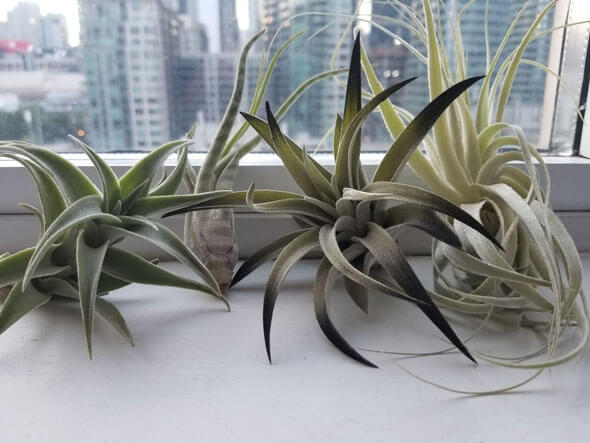
In fact they're so easy going they can even do perfectly well sitting bare on a windowsill.
I remember the last time Air Plant's were popular around a decade or so ago. They were sold glued to cheap and tatty looking ornaments. The scrappy care instructions they came with, often told the buyer that the plants needed nothing to survive but air. A terrible lie.
Fortunately the revival and resurgence in popularity of these houseplants comes with a lot of more knowledge and innovative ways of displaying these very unique looking plants.
Despite the name, Air Plants can't live on air alone.
Despite the name, Air Plants can't live on air alone. Don't listen or pay attention to anyone who tells you otherwise. These are living breathing plants that like everything else on the planet needs water to survive.
It's true they can go longish periods without water but this means the Air Plant will just be a surviving rather than thriving houseplant. But if you're here reading our article I'm guessing you don't want your Air Plant to just get by, you want it to prosper and positively thrive. Don't worry, we're going to help.
Most species growing in their native habitats will absorb moisture and nutrients through the leaves from rain, dew, and decaying leaves. We don't have rain, dew or decaying leaves in our homes so you will need to give your plant a helping hand by caring for it properly.
All the correct care instructions you'll need to provide (it's pretty simple stuff) is detailed in full a bit further down the page. First though we're going to take a quick look at where you can get them from and at some of the choice on offer.
When it comes to buying houseplants, online purchasing can have some disadvantages in respect of the delivery. Larger houseplants can easily become damaged or suffer negative effects from the transportation journey. However Air Plants are by their nature, pretty small and extremely hardy so are much more likely to arrive in perfect condition.
A competent online seller can easily ensure you get what you've paid for, so in that respect buying Air Plants online can work out to be super value. Check out the Amazon link below to see what's on offer.
The varieties and species that are suitable for indoor growing are huge. Perhaps the most popular and commonly found is Tillandsia ionantha or the Sky Plant (second picture in the photo gallery). Tillandsia argentea is very similar but the leaves are a bit thinner. Both Tillandsia bulbosa and Tillandsia caput-medusae (plants in the middle row in the above picture) have less leaves and a thicker bulb like base.
Tillandsia tectorum (photo right) is perhaps the most popular "grey" Air Plant which is covered in Trichomes giving it an almost fury appearance (a bigger photo is in the gallery if you need it). 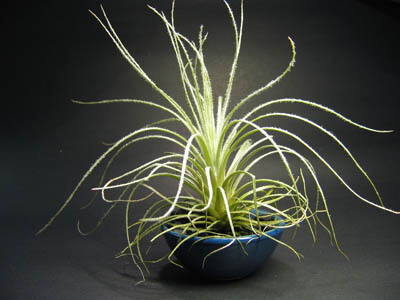 Then to round up the most commonly found Air Plants we have Tillandsia Xerographica (first photo at the start of this page). This one has thicker, slightly curly leaves and a much wider spread.
Then to round up the most commonly found Air Plants we have Tillandsia Xerographica (first photo at the start of this page). This one has thicker, slightly curly leaves and a much wider spread.
Beyond the species there are many cultivars so you can get stripes, markings or different colourings between them. This amount of diversity can make it really hard to identify what you actually have.
That said if you really want to know what species you have, then it might be worth using the Wikipedia Index to browse through the pictures. Failing that, post a photo in the comments below and we're see if we can help you out with identification.
When it comes to these plants the care requirements are similar and because they're primarily visual plants, it's probably more important for you to pick the ones you like the look of.

Hi, I'm Tom!
If you're like me and enjoy the challenge of growing houseplants and getting them to thrive, then Ourhouseplants can help. This website shares my knowledge and years of growing plants and provides (hopefully) helpful advice on properly caring for your indoor plant friends.
The conventional wisdom is that all Air Plants must have bright light with the occasional bit of direct sun exposure. However in my experience I've found that Air Plants can actually do reasonably well in many different light conditions depending on the variety you have.
A general rule to follow is to look at the Air Plant's natural colour. The range starts from dark green through to light green and then into grey, before finishing up with some varieties which are almost white.
The green types will manage fairly well in areas which don't receive a great deal of light, all the way up to some pretty bright spots on window ledges. However they don't like harsh direct sunlight.
Pro Tip - All varieties will struggle in very dark and no light areas, so this needs to be avoided for the long term health of your plants.
As you move to the grey / white types, the light intensity requirement increases and these ones will prefer bright light or even direct sunlight, but won't do as well in less bright locations.
If you've an Air Plant growing behind glass, in a terrarium for example, you absolutely must avoid placing the container in direct sunlight. It doesn't matter what colour plant you have - the glass will magnify the sun's heat and create excessively hot temperatures.
There are two primary ways of watering Air Plants. The first is spraying the leaves with a mister two or three times a week. This is quite useful when your plant is fixed in place, such as mounted on a wall, or it's too difficult to try the next method.
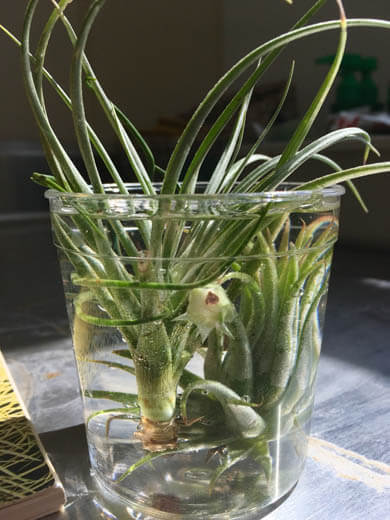 The second option is to dunk your Air Plant in a container of room temperature water. Some people will say a dunk isn't enough and instead you'll need to soak the plant in the container for half hour or longer.
The second option is to dunk your Air Plant in a container of room temperature water. Some people will say a dunk isn't enough and instead you'll need to soak the plant in the container for half hour or longer.
I don't necessarily disagree with this, especially if you live in a very arid place, or your plant is extremely dehydrated. But soaking in this way on a regular basis, makes taking care of these plants difficult and much more time consuming that it actually needs to be.
Instead I find they're perfectly happy and still get an effective watering by dunking in the container for no more than 15 seconds before removing them and shaking off the excess water.
What's important here is to shake off any excess water and leaving enough time for the plant to fully dry before night falls and the temperatures drop. If there is too much moisture around the plant and it gets cold then there is potential for rotting to occur. So in general try and water in the morning rather than late in the evening.
This can be important. Air Plants which are dark to light green will typically need more frequent water and a higher humidity level than the grey types.
If you can provide a mist / soak once or twice a week you should be fine and humidity can largely be ignored. However if watering that often is a struggle for you, then as a compromise the humidity must be reasonably high.
A feed at least a few times a year is a good idea as it will give you a strong healthy Air Plant in the long term. You could use a specialist bromeliad, cactus or orchid feed, or just a regular houseplant fertiliser diluted to half strength (they don't need much).
Avoid fertilizers that contain boron, copper or zinc
The only catch is to avoid fertilizers that contain boron, copper or zinc as all three metals are toxic to the majority of Tillandsias, including Air Plant's.
The feed can then be applied to the leaves in the mister spray or in the container of water if you're dunking / soaking your plant.
When it comes to temperature requirements these plant's are happy providing it ranges somewhere between 10°C (50°F) up to 30°C (86°F). Some varieties can deal with colder temperatures but it's not ideal as it drastically increases the chances of rotting.
The wonderful trait of of not having any sort of extensive root system means this is one of the very few houseplants that will never need repotting. Ever.
The Air Plant can be propagated by the seed it might produce at the end of its life, but this normally only works if you have multiple Air Plants in flower at once so they can pollinate one another. Additionally it needs specific requirements for germination to occur and also for the plants to survive into adulthood. If you're still keen to give it a go the RHS has a good guide.
Instead it's much easier if you skip all that and wait for the flower spike to die off. Around this time offsets or "pups" will form around the base of the mother plant. You can leave them to form an attractive clump, or instead when they're almost a third of the size of the mother plant you can gently separate them and treat them as individual plants.
Offsets grow quite quickly to start with, but then everything slows down and this continues for the rest of the plant's life. Don't expect fast growth no matter what you do for your Tillandsia.
The diversity available means the height and spread can differ a fair bit between plants. However Air Plants in the main are not large houseplants and they probably won't grow much bigger than what you have when you first buy them.
The flowering of any Tillandsia like the one in the photo below by Cactanna is often bittersweet. On one hand it shows you've raised and cared for it correctly and to a good standard. On the other hand it also marks the end of the plants life.
It takes many years, but Air Plants only flower once and when they do, the Mother Plant starts to lose it's vigor and will deteriorate before dying off.
During this die off period it will spend all it's energy producing as many "pups" or offsets as it can. Once grown to a fair size, they can be separated from the mother plant or left to form an attractive clump.
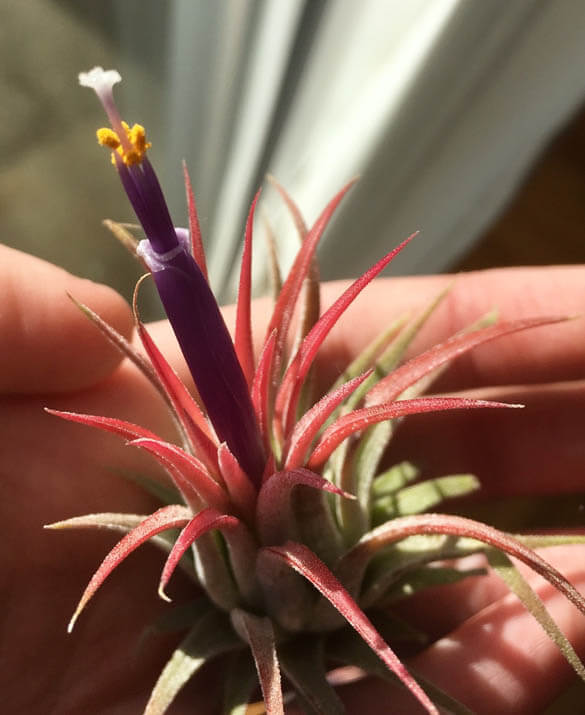
It all depends on the variety you have, but the blooms themselves can be very short lived only lasting a day or so, or they can stick around for a month or more. Regardless they're often striking, sometimes alien looking but somehow still pleasing to the eye.
The good news is that Air Plant's aren't poisonous to people or the majority of pets like cats and dogs. The bad news is that due to their unusual look they can attract playful and curious pets.
Don't let your pets play with them as their dainty size can mean they're easily damaged by teeth or claws.
You can grow these plants pretty much anywhere and in anything. They even make it into our list of Best plants for the bedroom. However be sure any container you place it in has a free flow of air, i.e. not in sealed bottles.
Additionally if mounting or if you want to hold it in place using wire, make sure you avoid superglue and wire containing copper. Both can do serious damage to your Air Plant.
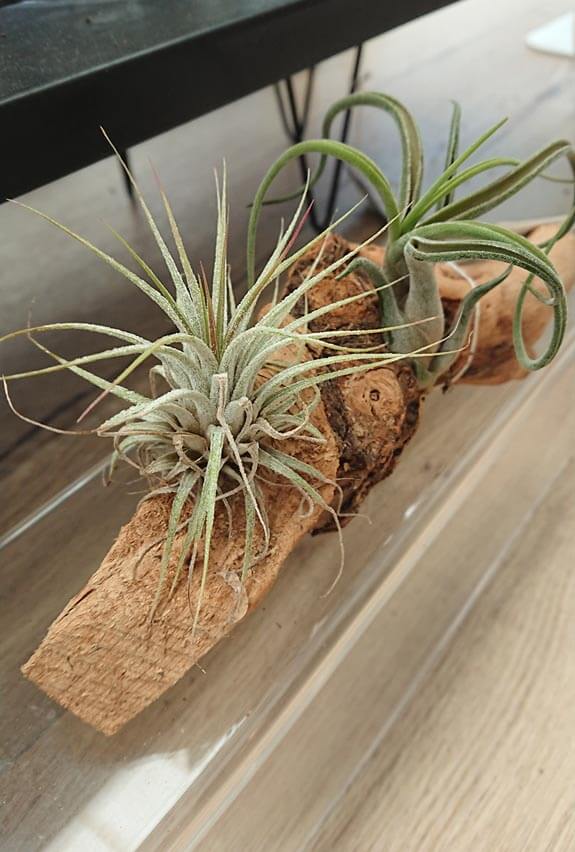
Average Light Levels An adaptable houseplant that can do equally well in moderately lit or brightly lit spaces. Avoid placing in deep shade for prolonged periods.
Moderate Watering Water well either by misting a few times a week, or dunking the entire plant in a bowl of water.
Temperature They need temperatures between 10°C (50°F) up to 30°C (86°F).
Feeding Feed once every two or three months all year round for a healthy looking plant. Add the feed to the mister or bowl of water.
How do I make my Air Plant flower?
By this I assume you're concerned that your Air Plant isn't flowering. Firstly I would mention that once an Air Plant blooms it dies, so while very beautiful and a rare sight to see, it's not like a normal flowering plant which repeat blooms.
To get your Air Plant to flower there is no magic trick, it's just a case of providing correct care and waiting until it's ready.
My Air Plant's not growing
Unless the plant is very young, little to no growth is usual and not a cause for alarm. In fact I'd go as far as saying this isn't actually a problem and if your plant is healthy just go with it and enjoy your little houseplant.
Brown Leaves
Large sections of the leaves which have gone brown (and not just the tips) are a sign of various damage or poor handling over time. The leaves are pretty small anyway so some damage from handling the plant is really common as shown in the picture below.
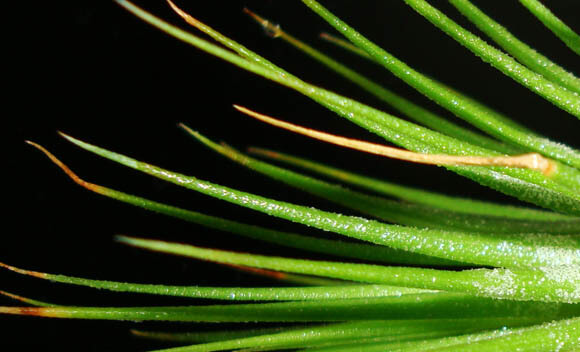
You can snip the brown bits off. If you have an Air Plant which has larger leaves than the one in the picture then make sure you cut in angles rather than straight across so what's left of the leaf blends in with the others.
Brown Leaf Tips
The brown tip problem is also shown in the picture above. As you can see it's only the very ends that have gone brown rather than large sections of the leaves. In this instance the brown tips are a sign of either frequent underwatering, prolonged low humidity or a combination of both. Improve the situation and again you can snip the brown tips off to fix the appearance.
When the leaves curl drastically or shrivel up, it's telling you that it needs water and urgently. Curling leaves is the last ditch attempt for the Air Plant to try and prevent water loss by reducing the leaf surface area to moisture stealing draughts and light.
To fix this, water well and consider a long soak in a bowl of water to rehydrate the plant. The leaves should have fully opened again within a few days.
What's the Difference between green and grey Tillandsias
There isn't really a huge difference. Although the greener species have less trichomes (tiny structures on the leaves that help the plant capture and absorb moisture and nutrients) than the greyer Air Plants.
In terms of care requirement needs, the greener types will likely need more frequent watering and do much better in shadier spots and terrariums. Where as the greyer types will benefit more from higher humidity locations and brighter areas in the home.
What should I do about the roots on my Air Plant?
The majority of Tillandsia species are epiphytes, which simply means they grow on the surface of another plant. In order to help remain attached they do tend to grow superficial supporting roots to help them "cling on".
When Air Plants are grown indoors as houseplants the roots serve very little purpose, so they can be trimmed or removed if undesired. Equally however there is no harm in leaving the roots alone. Personally I've not found that any of the Air Plants I've owned to produce many, or any roots so have not had to trim / remove them.
My plant's gone brown and mushy?
Both symptoms are a very clear sign your plant's rotted. Watering too frequently, doing it late in the evening when the temperatures are cooler, or exposure to very cold temperatures are all going to cause this result.
Credit for the collection of 4 Tillandsia - Article / Gallery - Beautiful Tillandsia
Credit for the collection of 5 Tillandsia - Article / Gallery - Amazon
Credit for the Air Plants having a water bath - Article / Gallery and for the Flowering Air Plant - Article / Gallery - Cactanna
Credit for the Air Plants having a soak in orange bowl - Gallery - A Bird's Life
Credit for Tillandsia tectorum in the blue bowl - Article / Gallery - James Ho